It was an ordinary surgery to remove a tumor — until doctors turned off the lights and the patient's chest started to glow. A spot over his heart shined purplish pink. Another shimmered in a lung.
They were hidden cancers revealed by fluorescent dye, an advance that soon may transform how hundreds of thousands of operations are done each year.
Click to Gallery
It was an ordinary surgery to remove a tumor — until doctors turned off the lights and the patient's chest started to glow. A spot over his heart shined purplish pink. Another shimmered in a lung.
Surgeon Dr. Sunil Singhal poses for a photograph with a vial of fluorescent dye at the Hospital of the University of Pennsylvania in Philadelphia, Tuesday, Jan. 23, 2018. (AP Photo/Matt Rourke)
Surgery has long been the best way to cure cancer. If the disease recurs, it's usually because stray tumor cells were left behind or others lurked undetected. Yet there's no good way for surgeons to tell what is cancer and what is not. They look and feel for defects, but good and bad tissue often seem the same.
Dr. Sunil Singhal surgically removes a tumor from his patient at the Hospital of the University of Pennsylvania in Philadelphia, Tuesday, Jan. 23, 2018. (AP Photo/Matt Rourke)
"I looked up and saw all these stars on the ceiling and I thought, how cool if we could make cells light up" so people wouldn't die from unseen tumors, he said.
Dr. Sunil Singhal, right, speaks with his patient Ryan Ciccozzi before his surgery at the Hospital of the University of Pennsylvania in Philadelphia, Tuesday, Jan. 23, 2018. During the surgery, Singhal used a fluorescent dye to find hidden cancer cells near Ciccozzi's heart and in a lung. (AP Photo/Matt Rourke)
In one study, the dye highlighted 56 of 59 lung cancers seen on scans before surgery, plus nine more that weren't visible ahead of time.
Ryan Ciccozzi is taken to surgery at the Hospital of the University of Pennsylvania in Philadelphia, Tuesday, Jan. 23, 2018. During Ciccozzi's surgery a fluorescent dye was used to find hidden cancer cells near his heart and in a lung.(AP Photo/Matt Rourke)
A device called MarginProbe is sold now, but it uses different technology to examine the surface of tissue that's been taken out, so it can't pinpoint in the breast where residual disease lurks, said Dr. Barbara Smith, a breast surgeon at Massachusetts General Hospital.

Dr. Sunil Singhal, second from right, directs a special camera to view a tumor in his patient made visible with a fluorescent dye, seen at monitor on right, at the Hospital of the University of Pennsylvania in Philadelphia, Tuesday, Jan. 23, 2018. (AP Photo/Matt Rourke)
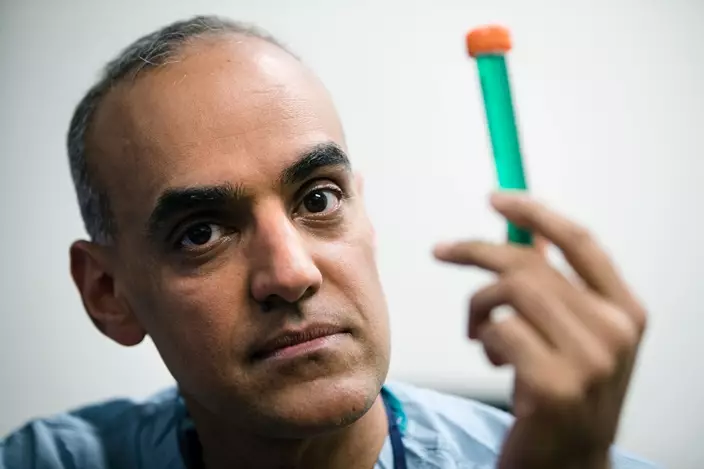
Surgeon Dr. Sunil Singhal poses for a photograph with a vial of fluorescent dye at the Hospital of the University of Pennsylvania in Philadelphia, Tuesday, Jan. 23, 2018. (AP Photo/Matt Rourke)
Surgery has long been the best way to cure cancer. If the disease recurs, it's usually because stray tumor cells were left behind or others lurked undetected. Yet there's no good way for surgeons to tell what is cancer and what is not. They look and feel for defects, but good and bad tissue often seem the same.
Now, dyes are being tested to make cancer cells light up so doctors can cut them out and give patients a better shot at survival.
With dyes, "it's almost like we have bionic vision," said Dr. Sunil Singhal at the University of Pennsylvania. "We can be sure we're not taking too much or too little."
The dyes are experimental but advancing quickly. Two are in late-stage studies aimed at winning Food and Drug Administration approval. Johnson & Johnson just invested $40 million in one, and federal grants support some of the work.
"We think this is so important. Patients' lives will be improved by this," said Paula Jacobs, an imaging expert at the National Cancer Institute. In five or so years, "there will be a palette of these," she predicts.
MAKING CELLS GLOW
Singhal was inspired a decade ago, while pondering a student who died when her lung cancer recurred soon after he thought he had removed it all. He was lying next to his baby, gazing at fluorescent decals.
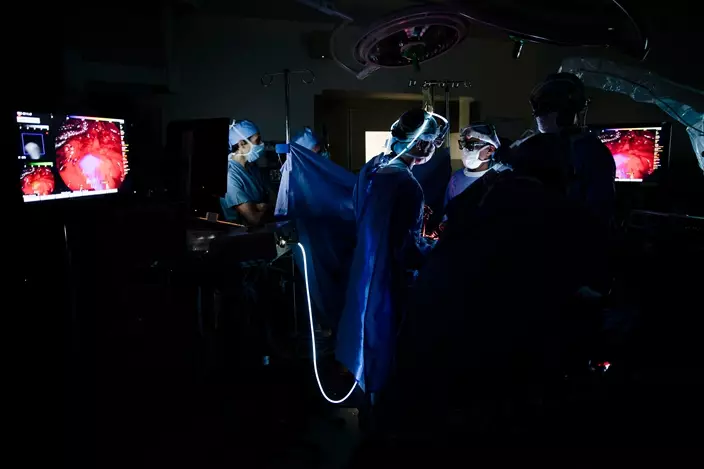
Dr. Sunil Singhal, center right, views a monitor to look at a tumor in his patient, made visible with the use of a special camera and fluorescent dye at the Hospital of the University of Pennsylvania in Philadelphia, Tuesday, Jan. 23, 2018. (AP Photo/Matt Rourke)
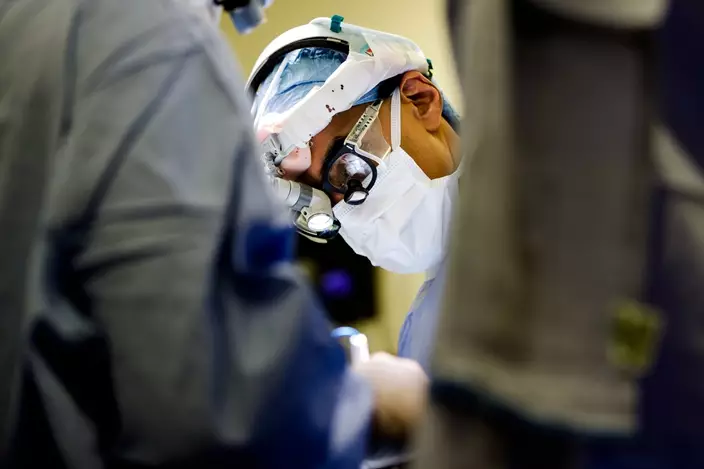
Dr. Sunil Singhal surgically removes a tumor from his patient at the Hospital of the University of Pennsylvania in Philadelphia, Tuesday, Jan. 23, 2018. (AP Photo/Matt Rourke)
"I looked up and saw all these stars on the ceiling and I thought, how cool if we could make cells light up" so people wouldn't die from unseen tumors, he said.
A dye called ICG had long been used for various medical purposes. Singhal found that when big doses were given by IV a day before surgery, it collected in cancer cells and glowed when exposed to near infrared light. He dubbed it TumorGlow and has been testing it for lung, brain and other tumor types.
He used it on Ryan Ciccozzi, a 45-year-old highway worker and father of four from Deptford, New Jersey, and found hidden cancer near Ciccozzi's heart and in a lung.
"The tumor was kind of growing into everything in there," Ciccozzi said. "Without the dye, I don't think they would have seen anything" besides the baseball-sized mass visible on CT scans ahead of time.
Singhal also is testing a dye for On Target Laboratories, based in the Purdue research park in Indiana, that binds to a protein more common in cancer cells. A late-stage study is underway for ovarian cancer and a mid-stage one for lung cancer.
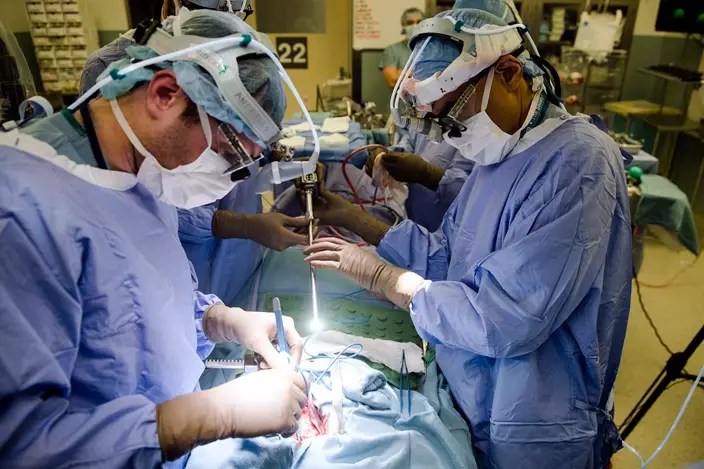
Dr. Sunil Singhal, right, directs a special camera to be able to view his patients tumor on monitors while performing surgery at the Hospital of the University of Pennsylvania in Philadelphia, Tuesday, Jan. 23, 2018. (AP Photo/Matt Rourke)

Dr. Sunil Singhal, right, speaks with his patient Ryan Ciccozzi before his surgery at the Hospital of the University of Pennsylvania in Philadelphia, Tuesday, Jan. 23, 2018. During the surgery, Singhal used a fluorescent dye to find hidden cancer cells near Ciccozzi's heart and in a lung. (AP Photo/Matt Rourke)
In one study, the dye highlighted 56 of 59 lung cancers seen on scans before surgery, plus nine more that weren't visible ahead of time.
Each year, about 80,000 Americans have surgery for suspicious lung spots. If a dye can show that cancer is confined to a small node, surgeons can remove a wedge instead of a whole lobe and preserve more breathing capacity, said On Target chief Marty Low. No price has been set, but dyes are cheap to make and the cost should fit within rates hospitals negotiate with insurers for these operations, he said.
BIG PROMISE FOR BREAST CANCER
Dyes may hold the most promise for breast cancer, said the American Cancer Society's Dr. Len Lichtenfeld. Up to one third of women who have a lump removed need a second operation because margins weren't clear — an edge of the removed tissue later was found to harbor cancer.
"If we drop that down into single digits, the impact is huge," said Kelly Londy, who heads Lumicell, a suburban Boston company testing a dye paired with a device to scan the lump cavity for stray cancer cells.
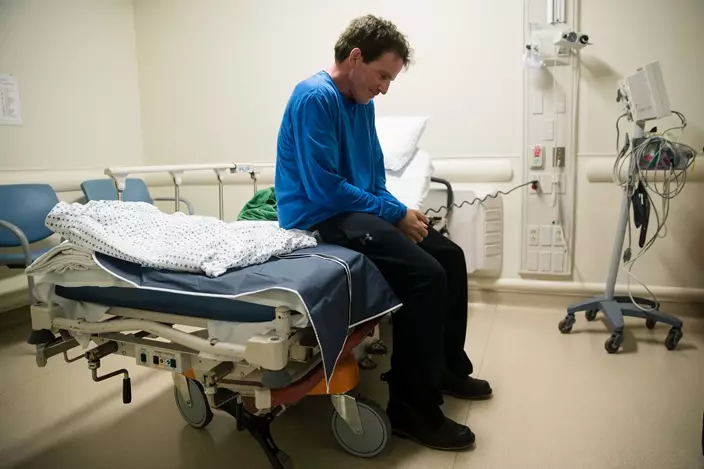
Ryan Ciccozzi prepares to go to surgery at the Hospital of the University of Pennsylvania in Philadelphia, Tuesday, Jan. 23, 2018. During Ciccozzi's surgery a fluorescent dye was used to find hidden cancer cells near his heart and in a lung. (AP Photo/Matt Rourke)

Ryan Ciccozzi is taken to surgery at the Hospital of the University of Pennsylvania in Philadelphia, Tuesday, Jan. 23, 2018. During Ciccozzi's surgery a fluorescent dye was used to find hidden cancer cells near his heart and in a lung.(AP Photo/Matt Rourke)
A device called MarginProbe is sold now, but it uses different technology to examine the surface of tissue that's been taken out, so it can't pinpoint in the breast where residual disease lurks, said Dr. Barbara Smith, a breast surgeon at Massachusetts General Hospital.
She leads a late-stage study of Lumicell's system in 400 breast cancer patients. In an earlier study of 60 women, it revealed all of the cancers, verified by tissue tests later.
But it also gave false alarms in more than a quarter of cases — "there were some areas where normal tissue lit up a little bit," Smith said.
Still, she said, "you would rather take a little extra tissue with the first surgery rather than missing something and have to go back."
OTHER CANCERS
Blaze Bioscience is testing Tumor Paint, patented by company co-founder Dr. Jim Olson of Fred Hutchinson Cancer Research Center and Seattle Children's Hospital. It's a combo product — a molecule that binds to cancer and a dye to make it glow.
"You can see it down to a few dozen cells or a few hundred cells," Olson said. "I've seen neurosurgeons come out of the operating room with a big smile on their face because they can see the cancer very clearly."
Early-stage studies have been done for skin, brain and breast cancers in adults, and brain tumors in children.

Patient Ryan Ciccozzi, left, waits with his brother-in-law Ron Grzechowiak before his surgery at the Hospital of the University of Pennsylvania in Philadelphia, Tuesday, Jan. 23, 2018. (AP Photo/Matt Rourke)
Avelas Biosciences of San Diego has a similar approach — a dye attached to a molecule to carry it into tumor cells. The company is finishing early studies in breast cancer and plans more for colon, head and neck, ovarian and other types.
Cancer drugs have had a lot of attention while ways to improve surgery have had far less, said company president Carmine Stengone.
"This was just an overlooked area, despite the high medical need."
DES MOINES, Iowa (AP) — Stung by paying billions of dollars for settlements and trials, chemical giant Bayer has been lobbying lawmakers in three states to pass bills providing it a legal shield from lawsuits that claim its popular weedkiller Roundup causes cancer.
Nearly identical bills introduced in Iowa, Missouri and Idaho this year — with wording supplied by Bayer — would protect pesticide companies from claims they failed to warn that their product causes cancer, if their labels otherwise complied with the U.S. Environmental Protection Agency’s regulations.
But legal experts warn the legislation could have broader consequences — extending to any product liability claim or, in Iowa’s case, providing immunity from lawsuits of any kind. Critics say it could spread nationwide.
"It’s just not good government to give a company immunity for things that they’re not telling their consumers,” said Matt Clement, a Jefferson City, Missouri, attorney who represents people suing Bayer. “If they’re successful in getting this passed in Missouri, I think they’ll be trying to do this all over the country.”
Bayer described the legislation as one strategy to address the “headwinds” it faces. About 167,000 legal claims against Bayer assert Roundup causes a cancer called non-Hodgkin’s lymphoma, which Bayer disputes. The company has won some cases, settled many others but also has suffered several losses in which juries awarded huge initial judgments. It has paid about $10 billion while thousands of claims linger in court.
Though some studies associate Roundup's key ingredient with cancer, the EPA has regularly concluded it is not likely to be carcinogenic to humans when used as directed.
The costs of “defending a safe, approved product” are unsustainable, said Jess Christiansen, head of communications for Bayer's crop science division.
The legislation was introduced in targeted states pivotal to Bayer's Roundup operations and is at a different stage in each. It passed the Iowa Senate, is awaiting debate in the Missouri House and was defeated in Idaho, where this year's legislative session ended.
Farmers overwhelmingly rely on Roundup, which was introduced 50 years ago as a more efficient way to control weeds and reduce tilling and soil erosion. For crops like corn, soybeans and cotton, it’s designed to work with genetically modified seeds that resist Roundup’s deadly effect.
Missouri state Rep. Dane Diehl, a farmer who worked with Bayer to sponsor the legislation, cited concerns that costly lawsuits could force Bayer to pull Roundup from the U.S. market, leaving farmers to depend on alternative chemicals from China.
“This product, ultimately, is a tool that we need," said Diehl, a Republican.
Iowa Gov. Kim Reynolds, a Republican, said in an email the legislation maintains the integrity of the regulatory process and, without it, “Iowa risks losing hundreds of jobs” in Muscatine, an eastern Iowa city where Roundup is mostly produced.
The Associated Press is seeking public records on Bayer’s communications with governor's offices in Iowa, Missouri and Idaho.
Bayer, like other companies, hires lobbyists in states to advocate for its interests. The company backs this legislation in the states where “we have a big, direct economic impact,” Christiansen said.
Roundup’s key ingredient, glyphosate, is derived from phosphate mined in Idaho. And St. Louis is the headquarters of its North America crop science division, acquired in its 2018 purchase of Monsanto. Because of that, many of the lawsuits are filed in Missouri.
The five lobbyists registered for Bayer in Iowa and three in Idaho is largely consistent with recent years, but the number working in Missouri this year ballooned from four to nine. Lobbyist expenditures exceeded $8,000 in Idaho this year; similar information was not available in Iowa or Missouri.
Led by Bayer, a coalition of agricultural organizations called Modern Ag Alliance also is spending tens of thousands of dollars on radio and print advertisements claiming that trial lawyers and litigation threaten the availability of glyphosate.
On its website, the group asserts that at risk are 500 jobs connected to glyphosate production in Iowa, and 800 jobs in Idaho.
Bayer stopped short of threatening closures. The Iowa facilities, including in Muscatine, “are very critical facilities to our business, so we'll remain at some sort of support level,” Christiansen said.
At issue in the lawsuits and legislation is how Bayer – and any other pesticide company — communicates with consumers about the safety of its products.
Companies are required to register products with the EPA, which evaluates — and then reevaluates every 15 years — a pesticide and its label. The EPA reiterated in 2020 that glyphosate used as directed posed no health risks to humans. But a federal appeals court panel in 2022 ruled that decision “was not supported by substantial evidence” and ordered the EPA to review further.
The debate over glyphosate escalated when a 2015 report by the International Agency for Research on Cancer, part of the World Health Organization, said it's “probably carcinogenic to humans" based on “limited” evidence of cancer in people and “sufficient” evidence in study animals.
Based on that international report, California sought to add a cancer warning label to products containing glyphosate. But a federal appeals court ruled against California last November, concluding such a warning wasn't factual.
Christiansen emphasized that many regulatory agencies worldwide agree with the EPA and insisted Bayer has to stick to EPA labeling to ensure it isn't providing false or misleading information. She added that the company is transparent in the information it does provide.
Critics of the legislation aren't convinced, citing examples such as opioids and asbestos that had been deemed safe for use as directed — until they weren't.
There also are concerns that the legislation could stifle any product liability claim since most rely on the argument that a company failed to warn, said Andrew Mertens, executive director of the Iowa Association for Justice, an organization for trial lawyers.
Jonathan Cardi, a product liability and torts expert at Wake Forest University School of Law, also said a strict reading of the Iowa legislation extends beyond liability claims, and “the way it’s drafted makes it interpretable to mean nobody could bring any suit.”
In lobbying lawmakers and in speaking with the AP, Bayer representatives disputed that the legislation would cut off other legal actions. Several legal experts said the legislation is unlikely to affect the 18,000 lawsuits already pending in Missouri’s capital of Jefferson City, and wouldn’t prevent claims in states that don’t adopt similar legislation.
In Idaho, the Republican-led Senate narrowly defeated the bill amid concerns about relying on federal agencies' safety standards and limiting the ability of harmed individuals to sue.
John Gilbert, who farms in Iowa Falls, Iowa, with limited use of Roundup, called Republicans hypocritical for attempting to protect corporate interests after campaigning on standing up for Iowans.
The bill “invites a lot of reckless disregard," said Gilbert, who is on the board for the Iowa Farmers Union. “No amount of perfume’s gonna make it anything but a skunk."
Lieb reported from Jefferson City, Missouri.

FILE - Soybeans are seen in a field on a farm, Friday, Sept. 2, 2016, in Iowa. The maker of a popular weedkiller is turning to lawmakers in key states to try to squelch legal claims that it failed to warn about cancer risks. (AP Photo/Charlie Neibergall, File)

FILE - The Bayer AG corporate logo is displayed on a building of the German drug and chemicals company in Berlin, Monday, May 23, 2016. Bayer, the maker of a popular weedkiller, is turning to lawmakers in key states to try to squelch legal claims that it failed to warn about cancer risks. Bayer disputes such claims but already has paid about $10 billion to resolve them. (AP Photo/Markus Schreiber, File)

FILE - Phosphate ore is dug up and transported from Monsanto Company's South Rasmussen Mine site near Soda Springs, Idaho, July 16, 2009. Bayer acquired Monsanto in 2018. Bayer, the maker of a popular weedkiller, is turning to lawmakers in key states to try to squelch legal claims that it failed to warn about cancer risks. The company disputes such claims. A key ingredient of the weedkiller, glyphosate, is derived from phosphate mined in Idaho. (Bill Schaefer/The Idaho State Journal via AP, File)
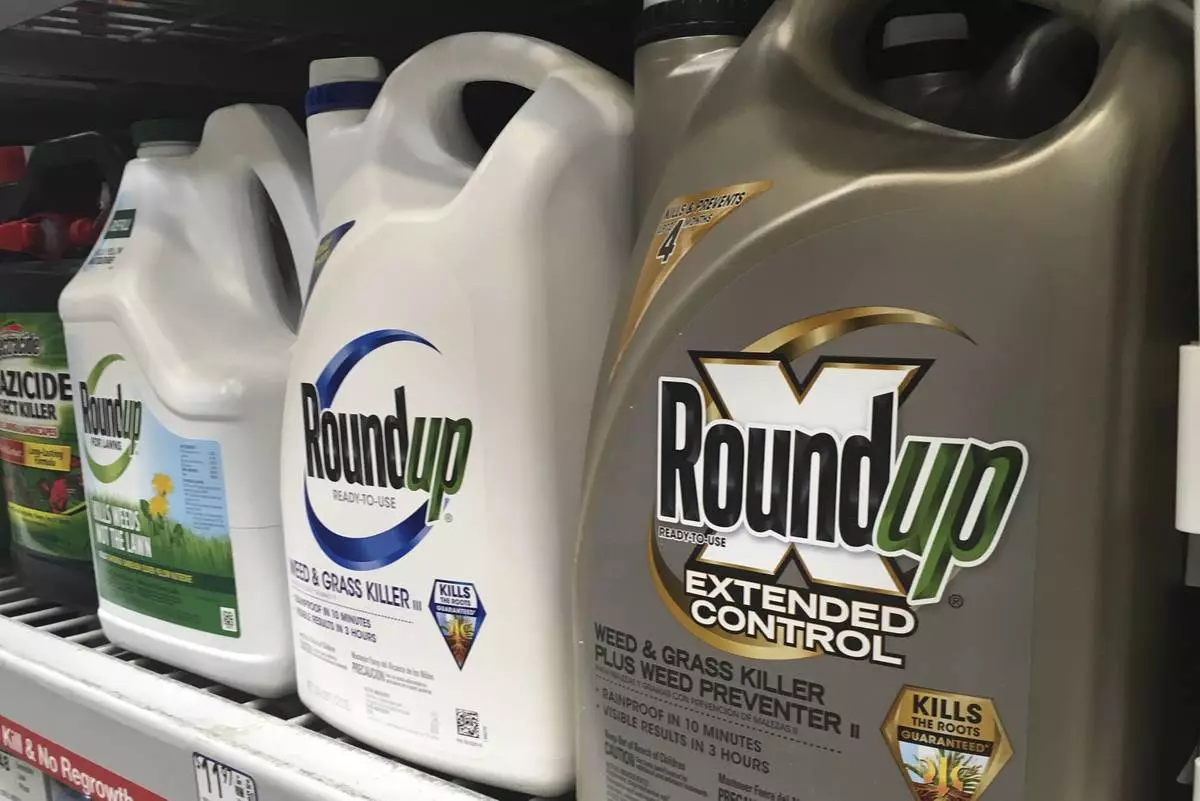
FILE - Containers of Roundup are displayed on a store shelf in San Francisco, Feb. 24, 2019. Thousands of legal claims against drug and chemicals company Bayer assert Roundup causes a cancer called non-Hodgkin’s lymphoma, which Bayer disputes. (AP Photo/Haven Daley, File)

FILE - A soybean field is sprayed in Iowa, July 11, 2013. The maker of a popular weedkiller is turning to lawmakers in key states to try to squelch legal claims that it failed to warn about cancer risks. (AP Photo/Charlie Neibergall, File)






















